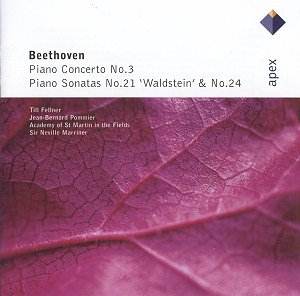Here is a sensible programme, eminently sensibly played. As
one might expect with the Academy of St Martin’s and Marriner, the orchestral
contribution to the Third Concerto is clean as a whistle, with very little
to complain about but similarly with little to ignite the flow of Beethoven’s
best C minor mode. Thus the orchestra in the Largo, whatever its merits
regarding tuning, ensemble and balance, fails to enter Beethoven’s intimate
world. The whole performance is set in an over-reverberant acoustic that
hardly helps the impression of an orchestra going through its paces.
Till Fellner (too closely recorded) lacks subtlety,
and not only in the Largo. Semiquaver passages in the first movement
can be remarkably etude-like, and the cadenza threatens to nod off (it
is hardly Beethoven’s greatest creation anyway, and it really needs
a more attuned interpreter to ignite it – Pollini, with Böhm, succeeds
where many others fail). Indeed, with Fellner there is little or no
sense of the virtuoso – the coda to the work is careful rather than
exciting, and this sums up the entire experience. True, there are some
touching moments in the slow movement (rippling arpeggios and carefully
articulated scales), but they are hardly redemptive.
The two sonatas, recorded at a high level, herald a
change of pianist. Jean-Bernard Pommier is certainly more promising
than Fellner in the first movement of the Waldstein, where he
is tonally imaginative and shows a sure structural grasp. Unfortunately
the link between the Adagio molto Introduzione and the Rondo finale
is not the melting experience it can be. The Finale tends towards the
unsubtle and the music’s inherent energy fails to flow freely.
The F sharp Sonata, Op. 78 is a gem of a piece. Alas,
one would be hard-pressed to guess it with Pommier who, especially in
the first movement, does not appear to show the piece any respect whatsoever.
Although there is more evidence of energy in the finale, neither of
these performances can be recommended with any confidence.
A disappointment.
Colin Clarke
